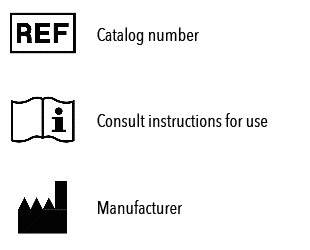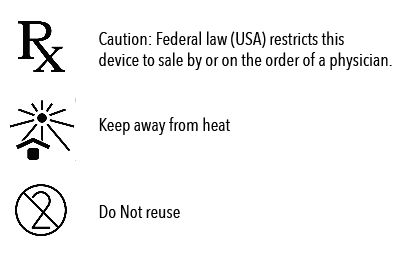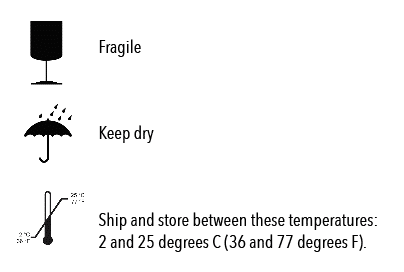Instructions for Use (Summary)*
- 1.0 The Aurix® System
- 2.0 Preparation
- 3.0 The Aurix® System Procedure
- 4.0 Composition, Storage and Handling of Aurix® System
1.0 The Aurix® System
1.1 The Aurix System Includes:
- Aurix System Centrifuge
- Aurix System Wound Dressing Kit including single-use components for patient phlebotomy, platelet rich plasma (PRP) processing, and patient application.
- Aurix System Reagent Kit including components for processing and activating the PRP.
1.2 Indications For Use
The Aurix System is intended to be used at point-of-care for the safe and rapid preparation of platelet-rich plasma (PRP) gel from a small sample of a patient’s own blood. Under the supervision of a healthcare professional, the PRP gel produced by the Aurix System is suitable for exuding wounds, such as leg ulcers, pressure ulcers, and diabetic ulcers; and for the management of mechanically or surgically debrided wounds.
1.3 Dosing
The Aurix System may be used for chronic or surgically-debrided wounds. The treating health care practitioner may elect to continue the treatment up to twelve (12) weeks. The Aurix System should be used in conjunction with standard of care procedures as prescribed by a healthcare professional for comprehensive wound management such as:
- Removal of necrotic or infected tissue
- Off-loading
- Compression therapy for venous stasis ulcers
- Establishment of adequate blood circulation
- Maintenance of a moist wound environment
- Management of wound infection
- Wound cleansing
- Nutritional support, blood glucose control for subjects with diabetic ulcers
- Bowel/bladder care for subjects with pressure ulcers at risk for contamination
- Management of underlying disease
The Centers for Medicare & Medicaid Services (CMS) will reimburse for autologous platelet-rich plasma (PRP) for the treatment of chronic non-healing diabetic wounds, using an FDA-cleared device, under section 1862(a)(1)(A) of the Social Security Act (the Act) for a duration of 20 weeks.
1.4 Contraindications
Aurix is contraindicated in the following patients or wounds:
- Patients known to be sensitive to components and/or materials of bovine origin
- Patients on chemotherapeutic agents
- Wounds due to malignancy
- Wounds with active clinically diagnosed infection
1.5 Precautions And Warnings
Federal Law (U.S.A.) restricts this device to sale by or on the order of a physician.
Precautions: Throughout the processing procedure and application of Aurix, use universal precautions as defined by the facility policy and procedure manual. All parts of the procedure shall be performed in such a manner to minimize splashing, spraying, spattering, and generation of potential droplets.
Warnings: Aurix is produced with the use of bovine thrombin.
- Allergic reactions may be encountered in persons known to be sensitive to bovine materials.
- Because of thrombin’s action in the clotting mechanism, Aurix must not be injected or otherwise allowed to enter large blood vessels. Extensive intravascular clotting and even death may result.
1.6 Symbols And Certifications



2.0 Preparation
2.1 Determine Amount of PRP Needed
The amount of PRP needed is in relation to the wound size. Normal hematocrit levels will yield approximately 50% of blood drawn as PRP Gel. The gel is applied as a thin contact layer to the wound surface. The treating clinician may determine to treat selected areas within the wound if the amount of PRP is limited. Complete coverage of wound surface is recommended, however it is not required.
2.2 Prepare the Centrifuge
- Place the Aurix System Centrifuge on a smooth, secure surface near electrical receptacle.
- Plug the centrifuge directly into a grounded electrical socket.
- The centrifuge will beep and the cover will unlatch once it is plugged in.
- If the cover does not open, press the red button or insert an open paper clip into the small hole in the front of the centrifuge and press inward to manually open the cover.
2.3 Prepare Supplies from the Aurix System Wound Dressing Kit
The Kit consists of two detachable trays. Tray 1 contains phlebotomy/ blood collection supplies. Tray 2 contains processing and application supplies. Always use aseptic techniques when working with syringes and needles. Exercise caution to avoid injury.
Tray 1 – Phlebotomy:
Remove and set aside materials intended for venipuncture and blood collection including the S-Monovette® tubes prefilled with ACD-A anticoagulant, Safety-Multifly® set, tourniquet, gauze pads, alcohol pads and adhesive bandage.
Tray 2 – Processing and Application
- Attach the stopcock to the 20mL mixing chamber syringe. This controls the ports.
- Attach the 16 gauge blunt needle to the male end of the stopcock, the blunt needle port.
- Remove the cap from the female side port of the stopcock, the reagent port.
- Set aside the 3mL syringe and 5ml syringe for use with the reagent kit.
2.4 Prepare Reagents from the Aurix System Reagent Kit
The following reagents are required:
- Thrombin Topical (Bovine Origin), USP, 5,000 IU
- Calcium chloride injection, USP 10%, 100 mg/mL
- Ascorbic acid injection, USP 500 mg/mL
Calcium Chloride and Thrombin
- Use the 5 mL syringe with needle to draw 5 mL calcium chloride.
- Inject the 5 mL calcium chloride into the 5,000 I.U. thrombin.
- Gently rotate the bottle to mix the solution.
- Let stand for 5 minutes and retain the 5 mL syringe. The 5 mL syringe will be used again in Section 3.3, step 9.
Ascorbic Acid
- Locate the 3mL syringe to be used to withdraw the ascorbic acid, set aside.
3.0 The Aurix® System Procedure
3.1 Phlebotomy Step
The individual responsible for blood collection should be trained in venipuncture including aseptic technique, proper skin preparation and continued protection of the site
- Vacuum charge the S-Monovette tubes by pulling the monovette plunger to full extension. Once the plunger locks, break off the plunger shaft. Do NOT open or break the screw cap seal once the S-Monovette has been charged.
- Wrap tourniquet proximal to the puncture site.
- Cleanse venipuncture site with alcohol prep.
- Palpate the vein then insert the Safety-Multifly needle through the skin into a vein. (Alternately, a PICC line adaptor for S-Monovette may be used to access blood).
- Push the white connector of the Safety-Multifly onto the vacuum charged S-Monovette and turn clockwise to secure. Allow the S-Monovette to completely fill. Remove the S-Monovette from the Safety- Multifly.
- Gently invert the S-Monovette tube to mix the blood with the anticoagulant. Place in the provided tube holder.
- Repeat steps 5 and 6 for each desired S-Monovette tube.
- Remove the tourniquet and the Safety-Multi-fly needle.
- Apply pressure to the site with 2” x 2” gauze. Apply a band-aid over the site.
- Holding onto the Safety-Multi-fly wings, slide the protective tubing over the needle and discard properly.
3.2 Centrifugation Step
- Wipe any blood residue off the S-Monovette screw caps with an alcohol wipe.
- Place the S-Monovette tubes in the Aurix Centrifuge in opposite holes to create a balance. If there are an odd number of tubes, use a spare S-Monovette tube with the same amount of liquid as a counter-balance.
- Close the cover; insure it is latched and stable.
- Press the Green Start button to start the 60 second spin.
- Once the centrifuge stops, the cover will open automatically.
- Carefully remove the S-Monovette tubes and place in the tube holder. Do not re-mix the red cell (bottom of tube) and PRP fractions (top of tube). Do not re-spin.
3.3 Processing Step
- Remove the cap from each S-Monovette tube.
- Open the blunt needle port to the mixing chamber by closing the reagent port.
- Gently draw the PRP (clear yellowish layer) from each S-Monovette into the mixing chamber syringe. Avoid drawing red blood cells into the mixing chamber.
- Recap each S-Monovette after transfer and discard properly.
- Determine the amounts of calcium chloride and thrombin and ascorbic acid needed based on the volume of PRP drawn into the mixing chamber (Chart A).
Chart A
- Open the reagent port to the mixing chamber by closing the blunt needle port.
- Add the ascorbic acid – Using the 3 mL syringe with needle, draw the appropriate (Chart A) amount of ascorbic acid into the syringe.

(Caution: Pressure may have built up inside the vial; insert the needle carefully. You may need to vent internal pressure in the vial prior to withdrawing the ascorbic acid). Discard the needle. Attach syringe to the reagent port, inject into the mixing chamber. Remove the 3 mL syringe and discard properly.
- Before adding calcium chloride and thrombin check to ensure:
• Patient positioning is appropriate for gel application.
• Wound preparation, debridement has been properly completed.
• Application of skin protectant film to peri wound intact skin as needed.
• Caregiver is ready to perform Aurix application. - Add the calcium chloride and thrombin – Use the same 5 mL syringe with needle to draw the appropriate (Chart A) amount of calcium chloride and thrombin into the syringe. Discard the needle. Attach syringe to the reagent port, inject into the mixing chamber. Remove the 5 mL syringe and discard properly.
- Open the blunt needle port to the mixing chamber by closing the reagent port. Gently invert the syringe several times to mix the reagents with the PRP. When bubbles in the syringe move slower, the PRP liquid is beginning to gel.
3.4 Application
PRP usually gels rapidly, within 15 – 30 seconds from mixing. To prevent difficulty expelling from the mixing chamber, perform Aurix application promptly following processing and activation
- Apply Aurix onto the wound area by first filling any undermined areas, tunnels, or sinus tracts using the blunt needle. Apply using N-Terface® or a gloved hand to spread a thin layer directly in contact with viable tissue.
- Apply the selected primary dressing (non absorbent, non cytotoxic) over the contact layer interface. Apply a secondary dressing (absorbent) to further secure and protect the primary dressing.
- These dressings may be left in place until the next Aurix treatment. If the secondary dressing becomes soiled, it should be changed. However, the primary dressing should be undisturbed for 24-48 hours post application.
- If the primary dressing is changed between Aurix applications, the wound bed may be carefully cleaned using extreme care to avoid disturbing new granulation tissue. No cytotoxic cleansers, anti-infectives or pressurized cleansing should be used. Appropriate moist wound dressings may then be applied until the next Aurix application.
3.5 Documentation
Document Aurix application and patient care as per facility policy.
4.0 Composition, Storage and Handling of Aurix® System
The single use Aurix System Wound Dressing Kit (AGSW-02) consists of the following components:
| Tray 1 | Phlebotomy | Count |
| Tourniquet | 1 | |
| Sterile alcohol prep pads | 2 | |
| Prefilled S-Monovette® syringe/tubes (5 mL) | 6 | |
| Safety-Multifly® Set | 1 | |
| Gauze sponges | 2 | |
| Sterile adhesive bandages | 1 | |
| Foam tube holder | 1 | |
| Tray 2 | Processing and Application | Count |
| 20mL mixing chamber, without needle | 1 | |
| Sterile alcohol prep pads | 2 | |
| Gauze sponges | 2 | |
| 5 mL syringe w/needle | 1 | |
| 3 mL syringe w/needle | 1 | |
| Three-way stopcock | 1 | |
| Blunt needle | 1 | |
| N-Terface® Dressing | 1 | |
| Skin Protectant Wipe | 2 | |
| Towel/drape | 1 | |
STORAGE: At room temperature, 15°C (59°F) – 25°C (77°F)
The Aurix System Reagent Kit (AGSR-03) consists of the following components:
| Reagent | Count | |
| Thrombin, Topical (Bovine Origin) USP, 5000 I.U., 5 mL vial | 1 | |
| Calcium Chloride, USP 10%, 100 mg/mL, 10 mL vial | 1 | |
| Ascorbic Acid, USP, 500 mg / mL, 50 mL vial | 1 | |
| STORAGE: Upon arrival or within 14 days of shipment, store at 2° C (36° F) – 8° C (46° F) |